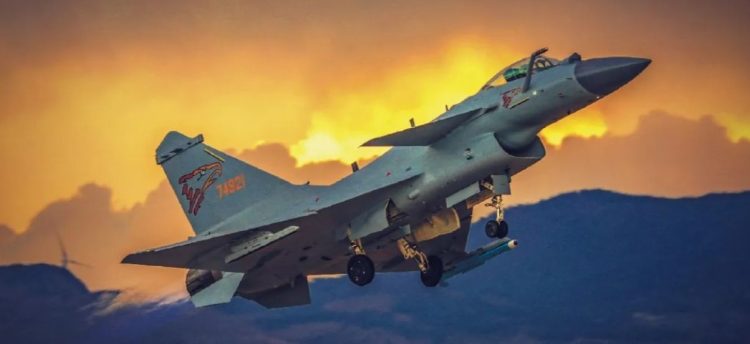 by Olawale Abaire, Warrior Editorial FellowChina’s relentless pursuit of global domination has seen it become a key player in the global arms trade, with significant economic growth and military modernization over the decades. However, one market where China’s ambitions have been thwarted is the market for modern fighter jets.When comparing the J-10 and J-20 to their US counterparts, several factors come into play. The J-10 is similar in performance and mission to the U.S. Air Force’s F-16. However, the J-20, often referred to as the Mighty Dragon, is often compared to the F-22 Raptor and the F-35, two of the USA’s finest. Despite China’s rapid improvement of its fighter force, it’s still smaller and less modern than that of its main rival.On paper, Chinese fighter jets rival their Western counterparts. However, their performance in real-world combat situations remains largely untested. These jets are flown by a single air force—the People’s Liberation Army Air Force—and have yet to train abroad or participate in actual combat. This lack of proven track record makes potential buyers wary, as they prefer established and proven options from countries with a long history of successful military aircraft development and deployment.
by Olawale Abaire, Warrior Editorial FellowChina’s relentless pursuit of global domination has seen it become a key player in the global arms trade, with significant economic growth and military modernization over the decades. However, one market where China’s ambitions have been thwarted is the market for modern fighter jets.When comparing the J-10 and J-20 to their US counterparts, several factors come into play. The J-10 is similar in performance and mission to the U.S. Air Force’s F-16. However, the J-20, often referred to as the Mighty Dragon, is often compared to the F-22 Raptor and the F-35, two of the USA’s finest. Despite China’s rapid improvement of its fighter force, it’s still smaller and less modern than that of its main rival.On paper, Chinese fighter jets rival their Western counterparts. However, their performance in real-world combat situations remains largely untested. These jets are flown by a single air force—the People’s Liberation Army Air Force—and have yet to train abroad or participate in actual combat. This lack of proven track record makes potential buyers wary, as they prefer established and proven options from countries with a long history of successful military aircraft development and deployment.
While China has offered many affordable jets in the China has indeed made strides in developing its own engines. The modern Russian turbofan jets and copied turbojet engines were followed by modern Chinese engines in the country’s production. However, the development and production of reliable, high-performance jet engines is an incredibly complex and challenging task that requires advanced technology, expertise, and years of research and development.
Unfortunately, the engines produced by China are more expensive than their Russian counterparts. This has especially hampered the sales of the JF-17, which lacks an affordable Chinese engine. Buyers, particularly those with long-standing relationships with Russia, are more likely to opt for a cheaper, more reliable Russian engine over a more expensive, unproven Chinese one.
According to the Pentagon’s latest assessment of Chinese military power, the People’s Liberation Army Air Force is upgrading the Chengdu J-20. The upgrades may include increasing the number of air-to-air missiles the fighter can carry in its low-observable configuration, installing thrust-vectoring engine nozzles, and adding super cruise capability by installing higher-thrust indigenous WS-15 engines.
Despite the growing Chinese aircraft industry and the development of advanced jets, demand for these modern Chinese fighter jets is low. This lack of demand can be attributed to three main factors: quality, price, and political influence.
Political influence plays a significant role in the sale of fighter aircraft. The international fighter aircraft market is not just about quality and cost, but also about decades-long partnerships and political ties. In this arena, China has struggled. Its actions, particularly in the South China Sea, have strained its relationships with potential buyers like the Philippines and India.
China’s foreign policy and arms sales strategy have been a significant factor in countries backing out from acquiring Chinese fighters. Countries that have no direct conflict with China often abandon deals due to international pressures. A notable example is Turkey, which canceled a massive $4 billion deal with China to acquire its high-end missile defense systems due to pressure from its NATO allies, particularly the U.S.
In conclusion, while China has made significant strides in developing advanced fighter aircraft, it faces several challenges in the global fighter jet market. These challenges include the quality and capabilities of its jets, the influence of Russia on its aircraft sales, and its own political influence. To overcome these challenges, China needs to demonstrate the reliability and performance of its jets in real-world combat situations, develop its own high-performance jet engines, and strengthen its political influence. Only then can it hope to compete effectively in the global fighter jet market.
—
Editor’s Note: This piece first appeared in Warrior Maven, a Military Group member website. It is reprinted here with permission.
Already have an account? Sign In
Two ways to continue to read this article.
Subscribe
$1.99
every 4 weeks
- Unlimited access to all articles
- Support independent journalism
- Ad-free reading experience
Subscribe Now
Recurring Monthly. Cancel Anytime.

